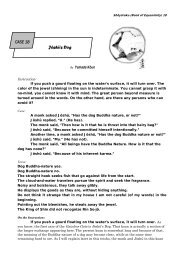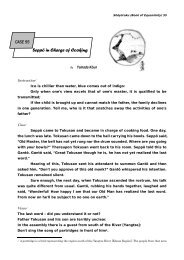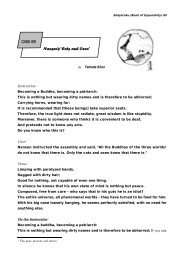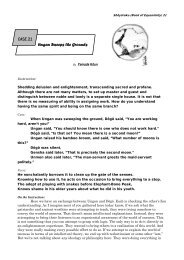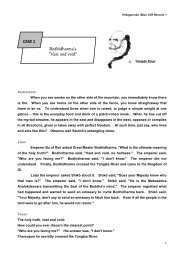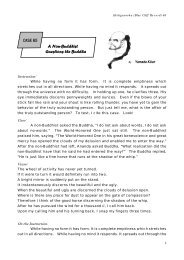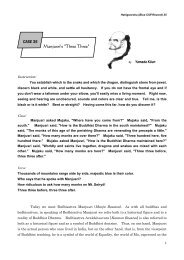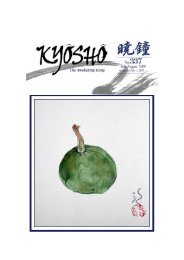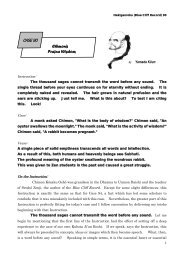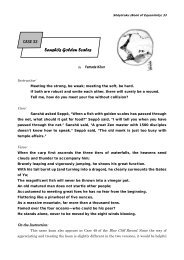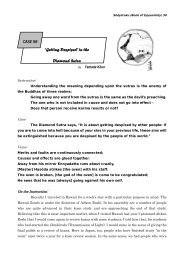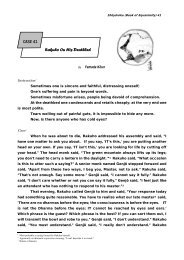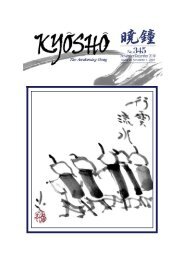CASE 89
CASE 89
CASE 89
Create successful ePaper yourself
Turn your PDF publications into a flip-book with our unique Google optimized e-Paper software.
Hekiganroku (Blue Cliff Record) <strong>89</strong><br />
<strong>CASE</strong> <strong>89</strong><br />
Ungan’s Hands and Eyes<br />
By Yamada Kôun<br />
Instruction:<br />
The entire body is an eye; there is no seeing. The entire body is an ear; there<br />
is no hearing. The entire body is a mouth; there is no speaking. The entire body<br />
is a mind; there is no thinking. Putting aside for the time being the matter of the<br />
entire body, if you suddenly do not have eyes, how do you see? If you do not<br />
have ears, how do you hear? If you do not have a mouth, how do you speak? If<br />
you do not have a mind, how do you think? If you are able here to produce a<br />
single way, you practice together with the ancient Buddhas. Leaving aside<br />
matters of practice, just tell me, who will you practice under?<br />
Case:<br />
Ungan asked Dôgo, “ What does the Bodhisattva of Great Compassion do with<br />
all his hands and eyes?” Dôgo said, “It is like a person groping for his pillow in<br />
the middle of the night.” Ungan said, “I understand.” Dôgo said, “How do you<br />
understand?” Ungan said, “The whole body is hands and eyes.” Dôgo said,<br />
“What you say is very well said. However, you have only succeeded in saying<br />
eight parts.” Ungan said, “How is it for you?” Dôgo said, “Throughout the body<br />
is hands and eyes.”<br />
Verse:<br />
“Whole body,” that's it.<br />
“Throughout the body,” that's it.<br />
Although you may have brought something forth,<br />
it is still a hundred thousand miles removed.<br />
Beating its wings, the Roc disperses the clouds in the six directions,<br />
Driving the wind to blow away the waters of the four seas.<br />
1
Hekiganroku (Blue Cliff Record) <strong>89</strong><br />
What is this dust that has suddenly appeared?<br />
Have those fine hairs not yet stopped?<br />
Don't you see how the jeweled net is let down<br />
to produce endless reflections?<br />
Where do the hands and eyes at the top of the stick come from?<br />
Totsu!<br />
We have come to the final teisho of this sesshin. How quickly the time passes. At such<br />
times the words, “Life and death are serious matters, all things pass quickly away” come home<br />
to me with particular force. I just received a telephone call saying that one of my coworkers<br />
from my days in Manchuria had just passed away. It's a lonely feeling as old friends go on to<br />
the next world one by one.<br />
The other day I was telling you about a monk who was in the habit of saying, “He'll be dead<br />
too someday!” to get over his chagrin when he lost at gambling. I actually used this as the<br />
theme for my latest Opening Comments in the Kyôshô magazine. When I was still practicing<br />
under Asahina Sôgen Roshi, former abbot of Engakuji in Kamakura, the Roshi once had<br />
occasion to speak about the Hannya-shingyô or Prajna-paramita Sutra during one of the<br />
zazenkai. Most of you are familiar with the beginning lines of that sutra: “When the<br />
Bodhisattva Avalokitesvara was engaged in deep Prajna-paramita, he clearly realized the<br />
emptiness of the five skhandas and passed beyond all suffering. O, Sariputra! Form is no<br />
other than emptiness, emptiness no other than form. Form is only emptiness, emptiness only<br />
form.”<br />
It is my firm conviction that the very essence of Buddhism and Zen is expressed in this<br />
short sutra. This is what is left when Buddhism has been condensed to the point where it<br />
cannot be condensed any further. “Engaged in deep Prajna-paramita” means that he had<br />
profoundly realized the wisdom of satori. At that instant he realized that all phenomena are<br />
totally empty and was thus relieved of all his suffering and anguish.<br />
These words in the sutra are attributed to Shakyamuni Buddha himself who was talking about<br />
Avalokitesvara during one of his sermons. Sariputra was one of the disciples of the Buddha.<br />
In other words, the Buddha was addressing his words to his disciple when he said that all<br />
phenomena are no other than emptiness itself, that emptiness is the phenomenal world itself.<br />
In speaking about that sutra on that occasion, Asahina Roshi told the following interesting<br />
story. Among the Roshi's friends was a monk who was extremely fond of gambling (probably<br />
hanafuda 1 ). He received invitations to gamble from all around but usually ended up losing.<br />
1<br />
A Japanese card game.<br />
2
Hekiganroku (Blue Cliff Record) <strong>89</strong><br />
Then he felt angry at the person who had won and would go around grumbling until he would<br />
finally cry out, “Oh well, he'll be dead someday, too!” This apparently had the effect of calming<br />
his spirits and he would then recover his composure.<br />
This, too, could be considered a sort of “seeing the emptiness of the five skhandas”! Since<br />
we all die, everything passes away. That realization was somehow of comfort to this monk.<br />
Asahina Roshi's comment was that the monk was “saving” himself to some degree by this<br />
realization, though it might not have been Prajna-paramita in the strictest sense.<br />
Few indeed are the people who would not be stopped short in their tracks by such a<br />
statement. Even a big politician, with all his power and influence, would be given cause to<br />
ponder if he were told, “You'll be dead someday, too!” What would you say in reply? This could<br />
also be a koan. If you are a true Zen person you must be able to repel this verbal attack. How<br />
would you do it?<br />
It's a matter of solving the problem of life-and-death. “Life and death are serious matters,<br />
all things pass quickly away.” If I were suddenly challenged with such a statement, I would say,<br />
“Go wash your face and come out again!” In other words, a true Zen person must realize that<br />
“My world knows neither life nor death” [Waga shari ni shôji nashi]. As Bankei Zenji said,<br />
“The unborn puts everything in perfect order.” If you are going to present yourself as a Zen<br />
person you must be able to say unflinchingly, “I know neither life nor death.” Then you can<br />
pass through any koan barrier with ease. The door to the inmost recesses of Buddhism will be<br />
opened to you. Indeed, I believe that the door to Christian heaven would be opened as well,<br />
since there is neither being born nor dying. I want you to realize clearly this fact that “There is<br />
neither life nor death in my world.”<br />
On the Instruction:<br />
The entire body is an eye; there is no seeing. This could be taken as meaning that<br />
we see with the whole of our physical body, but it would be better to see it as meaning the<br />
entire universe. The entire universe is an eye, in which case there is neither seeing nor being<br />
seen. That is why the Instruction says, “There is no seeing.” One of the Miscellaneous Koans<br />
which we work on immediately after kensho says, “If a person uses colors to see me or sounds to<br />
find me, that person is practicing a heretical path. He or she will not be able to see the<br />
Tathagatha.” What should you do? You must become one with the sounds and colors, you<br />
must forget yourself.<br />
You practice Mu to forget yourself by melting into Mu to the point where there is no longer<br />
any distinction between you and Mu. Since Mu is the entire universe which is completely<br />
empty, when you become one with Mu you suddenly realize your true empty self. The entire<br />
3
Hekiganroku (Blue Cliff Record) <strong>89</strong><br />
universe is an eye, in which case there is no one who sees and nothing which is seen since they<br />
are completely one. This is why the Instruction says, “There is no seeing.”<br />
The same goes for the next line: The entire body is an ear; there is no hearing. The<br />
entire universe is an ear since it is totally one. Thus, there is no sound which is heard and no<br />
one who hears since hearer and heard are completely one.<br />
Another koan included in the Miscellaneous Koans is, “Stop the sound of the distant<br />
temple bell.” I have people coming to me in dokusan with this koan and in reply they will use<br />
their hands to stop up their ears! This isn't going to stop the sound of that bell. The answer<br />
is actually very simple. It's simply a matter of becoming one with the sound so that there is<br />
neither the one listening nor the one listened to. What is left then? This is what you must<br />
show me.<br />
How about the next line? The entire body is a mouth; there is no speaking. This<br />
is the same as the preceding lines. In other words, the entire universe is a mouth. There is<br />
neither speaking nor no speaking. There is a verse in the sutras: “Though you talk the whole<br />
day long you have yet to say a word.” This is viewing things from the standpoint of the<br />
essential world, the world of complete emptiness. In the phenomenal world there is speaking<br />
the entire day. But viewing things from the essential standpoint there is no talking<br />
whatsoever. Shakyamuni Buddha's final words before he passed away were, “I have not said a<br />
single word in forty-nine years.” After the Buddha had his great enlightenment he spent the<br />
remaining forty-nine years of his life preaching the Dharma. Those sermons are recorded in<br />
the sutras of which there are some 1,800 separate texts. But from the essential point of view,<br />
Shakyamuni Buddha is completely right when he says that he never preached a word. It is<br />
just like a class in which the teacher may fill the blackboard with writing but erases it all at the<br />
end of the class.<br />
We could say the same thing about the next part of the Instruction. The entire body is<br />
a mind; there is no thinking. Since there is essentially no mind there is no thinking.<br />
Although we spend our entire day thinking about one thing or another there is actually not a<br />
single thought. This is said, of course, from the standpoint of the Zen person who has truly<br />
grasped the world of emptiness. As I am always telling you, if you have not yet realized<br />
emptiness you cannot understand the koans. They seem to be filled with contradictions.<br />
Thus, people of serious intent who know nothing about Zen will often shake their heads in<br />
disgust when they read koans, calling them illogical. This is especially true about scientists.<br />
However, when seen from the standpoint of the essential world, koans are just presenting the<br />
most ordinary facts. But you have to see this in actual experience; it can never be grasped by<br />
logic.<br />
4
Hekiganroku (Blue Cliff Record) <strong>89</strong><br />
Putting aside for the time being the matter of the entire body, if you suddenly<br />
do not have eyes, how do you see? If you do not have ears, how do you hear? If<br />
you do not have a mouth, how do you speak? If you do not have a mind, how do<br />
you think? We are told now to put aside the matter of the entire body, of the entire universe<br />
being one eye, ear, mouth, or mind. What if there is no eye? How do we see? Do you recall<br />
the line from the Surangama Sutra 2 ? “When I do not see, how is it that I do not see my not<br />
seeing?” We are asked in the dokusan room to present “when I do not see.” What is “not<br />
seeing”? It means to become just “one.” “Not seeing” means that there is neither seeing nor<br />
being seen. So, how would you reply to this koan? Can you give an answer?<br />
We are asked the same thing about ears, mouth and mind. But since this is difficult to<br />
understand, a single road should be opened up, a road from which we can understand this. If<br />
you are able here to produce a single way, you practice together with the ancient<br />
Buddhas. If we are able to produce this single way we practice together with Shakyamuni<br />
Buddha and the seven Buddhas of the past, which is to say that our state of consciousness is<br />
the same as theirs.<br />
Leaving aside matters of practice, just tell me, who will you practice under?<br />
But once again, putting aside for the time being this matter of practicing together with the<br />
ancient Buddhas, is there anyone among ordinary human beings like ourselves who has<br />
realized this and under whom we can practice? An example of such a person will be given now<br />
and we are advised to look carefully.<br />
On the Case:<br />
Ungan asked Dôgo “What does the Bodhisattva of Great Compassion do with<br />
all his hands and eyes?” Ungan and Dôgo were both students of Yakusan Zenji, with Dôgo<br />
the elder of the two. Ungan, whose full name was Ungan Donjô Zenji, was the teacher of<br />
Tôzan Ryôkai Zenji.<br />
One day, Ungan asked the question which appears in the case to his older brother monk.<br />
What does the Bodhisattva Kannon do with his thousand hands and eyes? The Bodhisattva<br />
Kannon [Sanskrit: Avalokitesvara] is the Bodhisattva of great compassion while Manjusri is<br />
the Bodhisattva of wisdom. Many images of Kannon will portray him or her with many hands<br />
and eyes of which there are said to be a thousand of each.<br />
In reply to this question, Dôgo said, “It is like a person groping for his pillow in the<br />
middle of the night.” “It is like a person who unconsciously gropes for his pillow in the<br />
middle of the night.” Hearing this, Ungan said, “I understand.” Dôgo said, “How do<br />
2<br />
The line forms the text of Case 88 in the Book of Serenity (Shôyôroku).<br />
5
Hekiganroku (Blue Cliff Record) <strong>89</strong><br />
you understand?” Now, “the whole body is hands and eyes,” was the reply. This is much<br />
the same as that which is said in the Instruction for this koan. In commenting on Dôgo's<br />
answer about groping for the pillow, Engo Zenji, in his short critical comments appended to the<br />
case, says that the answer is too lukewarm and fails to present the real fact just as it is. Dôgo,<br />
in Engo's eyes, is beating around the bush. What is the real fact? How would you present it<br />
in light of the initial questions about hands? Slap 3 ! That's how I would respond.<br />
Nevertheless, Ungan understood very well in spite of how lukewarm Dôgo's reply might<br />
have been. Ungan said, “The whole body is hands and eyes.” In response to this,<br />
Dôgo said, “What you say is very well said. However, you have only succeeded in<br />
saying eight parts.” You only get eighty percent for your answer, he says. How typical of<br />
a Zen exchange where no one ever gets a hundred percent no matter how fine their reply might<br />
be.<br />
Ungan said, “How is it for you?” “Well, older brother, how about you?” Dôgo said,<br />
“Throughout the body are hands and eyes.” I feel that Ungan's first statement, “the<br />
whole body is hands and eyes” is perfectly fine as an answer. Because the two monks use<br />
different expressions you might be tempted to conclude that the final answer is somehow<br />
deeper than the first. You might assume that Dôgo's answer was a hundred percent in<br />
contrast with Ungan's mere eighty.<br />
There are actually people who will proclaim out loud their conviction that the second<br />
answer is better than the first one. When I read statements of this sort I know immediately<br />
that that person does not know anything about Zen. For example, there is a statement of this<br />
sort in the book “Tea and Zen” [Cha To Zen]. Although this would no doubt have to be<br />
examined in detail in the dokusan room, you must be clearly aware of the aspect whereby both<br />
answers are exactly the same. When I slap with my hand this is both “the whole body is<br />
hands” and “throughout the body is hands.” How are they any different? Exactly the same.<br />
All body, all spirit [zenshin zenrei].<br />
On the Verse:<br />
“Whole body,” that's it. “Throughout the body,” that's it. Although you may have<br />
brought something forth, it is still a hundred thousand miles removed. Both “whole<br />
body” and “throughout the body” are on the mark. Nevertheless, if you just bring them forth<br />
as concepts, if there is the slightest intellection mixed in, they are far indeed from the truth.<br />
“If there is even a hairsbreadth of difference, it is like the difference between heaven and earth.<br />
“ What this means is that if we have some idea in our head when we say “the whole body is<br />
3<br />
Roshi makes a gesture of slapping.<br />
6
Hekiganroku (Blue Cliff Record) <strong>89</strong><br />
hands and eyes” or “throughout the body are hands and eyes,” it is miles away from the real<br />
fact.<br />
Beating its wings, the Roc disperses the clouds in the six directions, driving<br />
the wind to blow away the waters of the four seas. The next lines of the verse speak<br />
about the roc, a monstrous bird of Buddhist tradition. They are said in praise of the two<br />
monks who appear in the main case. The first of the two lines refers to Ungan's “the whole<br />
body is hands and eyes” and the second of the two lines is about Dôgo's “throughout the body<br />
are hands and eyes.”<br />
The great bird mentioned here also appears in the Taoist text attributed to Chuang Tz'u<br />
where it says, “With one beat of his wings, the roc travels nine-hundred thousand li.” It is said<br />
that this bird is actually the transfiguration of a great fish. When this bird beats its wings the<br />
four great oceans are emptied of their waters by the force of the wind to reveal the many<br />
dragons wriggling on the bottom which the great bird gulps down as its food. These words are<br />
said in praise of the statement “the entire body is hands and eyes.”<br />
“Driving the wind to blow away the waters of the four seas.” When the roc flies by, all<br />
clouds are blown away in an instant, so great is his strength. This is now said in praise of D-<br />
ôgo’s “throughout the body is hands and eyes.”<br />
What is this dust that has suddenly appeared? Although the poet has praised the<br />
two men in the Main Case for their answers, which might seem to be quite something, they are<br />
actually nothing more than concepts. The “dust” of concepts has suddenly made its<br />
appearance, the poet says. Having praised them up to now, he suddenly changes his tune.<br />
Have those fine hairs not yet stopped? This is saying the same thing with different<br />
words. The fine hairs refer to the extremely subtle thoughts and concepts still remaining.<br />
Then comes the next line in contrast: Don't you see how the jeweled net is let<br />
down to produce endless reflections? He has directed our attention to something far<br />
more wonderful than those answers in the koan. Upon reading these lines of the verse about<br />
the great roc, I recalled the statements of the astronauts who landed on the moon and who said<br />
the earth looked truly small from that vantage point. Thus, even if a great bird were to spread<br />
its giant wings on the earth and send the clouds scudding away, it amounts to nothing from this<br />
other vantage point. It is like so many fine hairs. The world of our essential nature is truly<br />
limitless. You could insert any number of universes into it without filling it. Seeing things<br />
from the standpoint of this essential nature, you can readily see these statements as so much<br />
dust and fine hairs and wonder why such concepts are still lingering!<br />
Let us return again to the next to the last line: “Don't you see how the jeweled net is let<br />
down to produce endless reflections?” These words originally appear in the Kegon [chin.:<br />
7
Hekiganroku (Blue Cliff Record) <strong>89</strong><br />
Hua-yen] Sutra in the Entering the Dharma World Chapter of that work. Here we can<br />
imagine a net to which diamonds, crystals and all manner of precious gems are attached. The<br />
net is completely covered with gems. In each single jewel are reflected all other jewels in an<br />
endless process of mutual reflection. This is like a curtain hanging down. The images of the<br />
jewels merge with each other to create a truly wondrous curtain. The poet points our<br />
attention to the existence of this beautiful world. Although he seemed to be praising the<br />
answers in the Main Case in the first lines of his poem, he now throws them down. It is said<br />
that Indra lives in this net of jewels, watching over that world. In that heaven is located<br />
Indra’s Dharma Hall of Goodness where this jeweled net is hanging in unimaginable splendor.<br />
Some of you may be wondering by now if such a world really exists. In fact, this is a<br />
description of our world. For each of us is a jewel in the sense that all beings are intrinsically<br />
Buddha. Each single thing is the full revelation of the whole. Our true world is not simply<br />
such a curtain; it is the entire universe. The entire phenomenal world is a great curtain<br />
covered with jewels giving forth their wondrous light. Each of you is a jewel. This is a truly<br />
wonderful world.<br />
Let us proceed now to the final line: Where do the hands and eyes at the top of the<br />
stick come from? This is speaking about the essential world. This stick 4 hits like this.<br />
Smack! But it mustn’t be a blind stick! A blind stick is a stick which hits indiscriminately.<br />
When you hit, your stick must have the eyes to distinguish when it is right to hit. This is true<br />
about the use of the kyôsaku, for example. The stick is used on someone who is dozing or<br />
whose spirits have been slackened. But very often the practitioners are hit in succession in<br />
the early morning hours so that the initial sleepiness is driven away; this is not a case of the<br />
stick having eyes.<br />
Here the line from the Verse is referring to the Main Case: “The whole body is hands and<br />
eyes.” “Throughout the body is hands and eyes.” “Where do those eyes and hands come<br />
from?” the poet asks us. You must clearly realize that they come from nowhere else but the<br />
essential world, from the world of total emptiness. But this is the emptiness that contains the<br />
entire universe.<br />
Totsu! He calls to us and asks us: “Have you understood?” “Just this!” Or it could be<br />
understood in the same way as “Katsu!”, blowing away all concepts. Anyway, the koan is over.<br />
“Totsu!” the poet tells us.<br />
4<br />
Roshi takes up his stick.<br />
8



